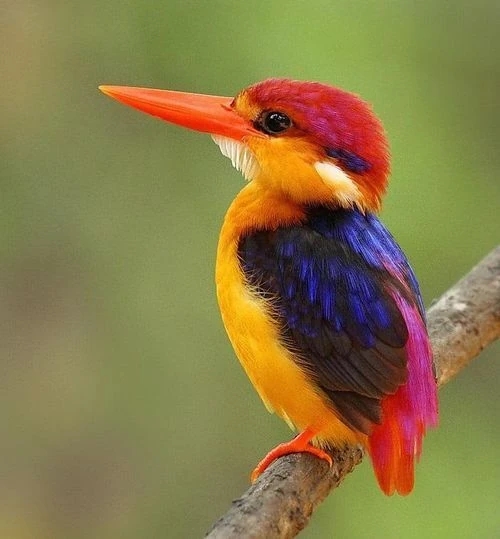The oriental dwarf kingfisher (Ceyx erithaca), also known as the black-backed kingfisher, is a tiny bird only slightly bigger than a hummingbird. They live in southeast Asia, where they inhabit evergreen and deciduous forests near streams and ponds. They stay low to the ground, where they perch and wait for prey to come close before darting out and snatching their meal. Learn everything there is to know about the oriental kingfisher, including where they live, what they eat, and how they behave.

5 Amazing Oriental Dwarf Kingfisher Facts
- They build their nests in underground tunnels that lead to an inclined egg chamber.
- This kingfisher species has three toes!
- Their population is decreasing from ongoing habitat destruction.
- The oriental dwarf is one of the smallest kingfishers.
- They migrate at night in large flocks.
Where to Find the Oriental Dwarf Kingfisher
Oriental dwarf kingfishers live in Asia in 15 countries, such as China, India, Thailand, Singapore, and the Philippines. Most populations are sedentary in their environments, but others in the northernmost region of their range migrate south for the winter. They inhabit forest and wetland habitats but are most commonly found in evergreen and deciduous forests. They like to live near forest streams and ponds with plenty of canopy shade. However, they keep their nests far away from water. Look for them low to the ground, where they perch and fly out to catch prey.
Oriental Dwarf Kingfisher Nest
They build their nests in stream banks or soil near the roots of a fallen tree. Both sexes dig a tunnel leading to an unlined egg chamber, which they build at an incline to help with drainage from water and waste.
Scientific Name
The oriental dwarf kingfisher (Ceyx erithaca) belongs to the Coraciiformes order in the Alcedinidae family, which encompasses the kingfishers primarily found in Africa and Asia. The Ceyx genus includes the river kingfishers from southeast Asia. There are three recognized subspecies of oriental dwarf kingfisher: C. e. Erithaca, C. e. Macrocarus, and C. e. motleyi.
Size, Appearance, & Behavior
The oriental kingfisher is a pocket-sized bird and one of the smallest kingfisher species. It measures four to six inches long and weighs 0.4 to 0.7 ounces, with an unknown wingspan. Males and females are similar in size and feature the same coloring: lilac crowns, rumps, and tails, dark blue and black wings, white chins and throats, yellow-orange underparts, red legs, feet, and bills, and black forehead spots. This kingfisher species has three toes and is sometimes referred to as the “three-toed kingfisher.”
This bird is mainly solitary, preferring to forage and perch alone. However, they form monogamous pairs during breeding, and some may join large flocks during migration. Their vocalizations include loud, high-pitched shrills and softer calls when in flight. And these little birds are swift and agile when hunting prey, but their exact speed is unknown.
Migration Pattern and Timing
These kingfishers are residents throughout most of their range. But the northernmost populations in Bangladesh and Myanmar will migrate south for the winter in Malaysia. They travel at night in large flocks from August to December.
Diet
The oriental dwarf kingfisher is a carnivore who forages alone on a low perch.
What Does the Oriental Dwarf Kingfisher Eat?
Their diet consists of mantises, grasshoppers, mayflies, winged ants, water beetles, and flies. They also eat spiders, worms, crabs, lizards, frogs, and small fish. This bird is a solitary hunter that forages from a post in low vegetation, flying out to capture its prey. They may also catch insects midflight, snatch spiders from their web, and pluck fish just below the water’s surface. They take larger creatures back to their perch, striking them with their beaks before consuming them.
Predators, Threats, and Conservation Status
The IUCN lists the oriental dwarf kingfisher as LC or “least concern.” Due to its extensive range, this species does not meet the “threatened” status thresholds. Their population is decreasing but not rapidly enough to meet vulnerable levels. Clearing of their forest habitat is their biggest threat, and their decrease is likely to continue from human activity. Their other hazards include pollution, hunting, electrocution from power lines, collision, exhaustion, and starvation.


